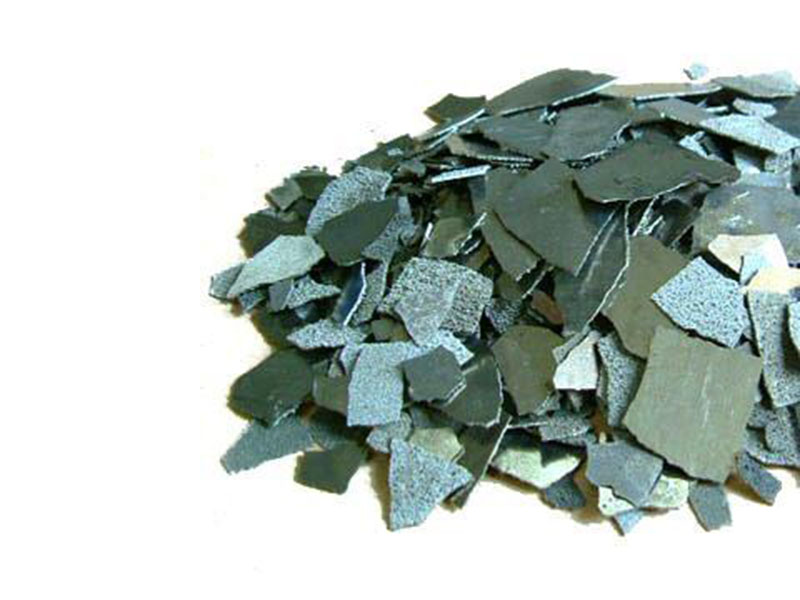Electrolytic manganese is a highly refined form of manganese metal produced through the electrolysis of manganese salts, which are derived from manganese ore through an acid-leaching process. The metal appears similar to iron, with an irregular, flake-like shape. It is hard and brittle, with one smooth, bright side and a rougher, darker side, ranging from silver-white to brown. When processed into powder, it takes on a silver-gray hue. Electrolytic manganese is highly reactive, easily oxidizing in air, dissolving in dilute acids with the release of hydrogen, and can even decompose water to release hydrogen at slightly above room temperature.

Electrolytic Manganese Grades and Uses
Electrolytic manganese is known for its high purity, typically achieving a purity of 99.7% to 99.9%. This high purity level makes EMM an essential material for enhancing the hardness of alloy materials. Among its most common applications are in manganese-copper and manganese-aluminum alloys, where it significantly improves the strength, toughness, wear resistance, and corrosion resistance of the alloys.
Applications of Electrolytic Manganese
Manganese and its alloys are indispensable in several critical industries, including steel production, aluminum alloy manufacturing, magnetic materials, and the chemical industry. In the metallurgical industry, manganese is a crucial additive in steelmaking, enhancing the strength and hardness of steel. The powdered form of electrolytic manganese is a key raw material in the production of manganese dioxide (MnO₂), which is widely used in the electronics industry for manufacturing magnetic materials.
Moreover, the aerospace industry, electronics sector, and various metallurgical processes rely heavily on electrolytic manganese. The growing technological advancements and the increasing complexity of industrial processes have expanded the application of EMM across a wide range of fields, including steel refining, non-ferrous metallurgy, electronic technology, chemical manufacturing, environmental protection, food hygiene, welding electrode production, and aerospace engineering. EMM’s high purity and low impurity content make it particularly valuable in these advanced applications.
Market Influences of Electrolytic Manganese
The price of electrolytic manganese is influenced by several factors, including supply and demand dynamics, electricity costs, and raw material availability. In China, which is a major producer of EMM, production is heavily concentrated in the southern regions where hydroelectric power is the primary energy source. The availability of electricity, which fluctuates between the wet and dry seasons, significantly impacts EMM production. Typically, the period from April to October sees ample rainfall and sufficient electricity, leading to stable production levels. However, during the drier months, reduced rainfall leads to tighter electricity supplies, which in turn can decrease production output.
Production Process of Electrolytic Manganese
China dominates the global production of electrolytic manganese, with the majority of its output consisting of 99.7% pure EMM, though many manufacturers have achieved purity levels of 99.8% or higher. Only a few producers manufacture EMM with 99.9% purity due to the limited market demand for such high-purity manganese. The primary raw materials used in EMM production are manganese oxide ore and manganese carbonate ore. The production processes for these two ores differ mainly in the initial solution preparation stage, but the electrolysis process itself is largely consistent.
For manganese carbonate ore, the production process involves reacting manganese carbonate with sulfuric acid to produce manganese sulfate solution, which is then neutralized, purified, and filtered to prepare the electrolyte. Additives such as selenium dioxide and ammonium sulfite are then added before the electrolyte is fed into the electrolytic cell for manganese deposition. The production of electrolytic manganese from manganese dioxide involves a slightly different approach, as manganese dioxide does not readily react with sulfuric acid under normal conditions. It must first be converted to a more reactive divalent manganese state, often through a roasting process, where manganese dioxide is mixed with a reducing agent, typically coal, and heated in a closed environment. The resultant manganese is then reacted with sulfuric acid to produce the manganese sulfate solution used in electrolysis. This roasting method is more commonly used, although it is less cost-effective and more environmentally taxing, especially when simple, high-energy-consuming reverberatory furnaces are employed.
Electrolytic Manganese and Stainless Steel
Electrolytic manganese is particularly well-suited for producing stainless steel and other high-performance alloy steels, where alloying elements exceed 10%. The demand for EMM in stainless steel production, particularly in high-end products like precision alloys, high-temperature steels, and corrosion-resistant steels, is expected to remain strong, driven by the continuous growth of the stainless steel industry and the increasing need for high-performance, high-quality steel.
As China’s economy and steel industry continue to grow, particularly in the stainless steel sector, the demand for electrolytic manganese is projected to increase. The ongoing efforts by steel companies to enhance product quality and optimize production processes will likely lead to greater consumption of EMM in the future, solidifying its role as a critical material in the production of high-grade steel.
Anyang Taizhihe Trading Co.,LTD
